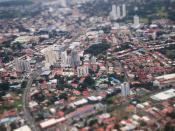Country Profile
Panama, republic in Central America, is located on the narrow strip of land that connects North and South America. Its position between two continents and separating two oceans has played a defining role in Panama's history and the livelihoods of its people. Panama is crossed by mountain ranges, covered with large areas of rain forest, and bounded by two long coastlines studded with islands and bays. At several places it spans less than a hundred miles from its Atlantic coastline to its Pacific shores. Most of its people and economic activity are located in the central region surrounding the Panama Canal, the major waterway that has played a decisive role in the country's history. Panama City, the capital and largest city, is on the Pacific coast in this central zone. The nation's diverse population is largely of mixed Spanish, black, and Native American descent, but includes indigenous people and immigrants from many parts of the world.
As a land bridge between two continents, Panama developed plant and animal life more diverse than almost anywhere else on Earth. Prehistoric inhabitants of the Americas crossed Panama to reach South America and continued to migrate back and forth, sharing trade goods and culture and using the rich natural resources of the isthmus.
The earliest Europeans to explore Panama recognized its value as a link between the Atlantic and Pacific oceans. For two centuries, Spain used Panama as a major commercial center in its American colonies, shipping trade goods and African slaves to Peru and thousands of tons of silver and gold to Spain. In the 17th century Panama handled a significant share of world trade.
Independence Day - 3 November 1903 (from Colombia; became independent from Spain 28 November 1821)
Capital City - Panama City
States - Panama's political divisions are...


